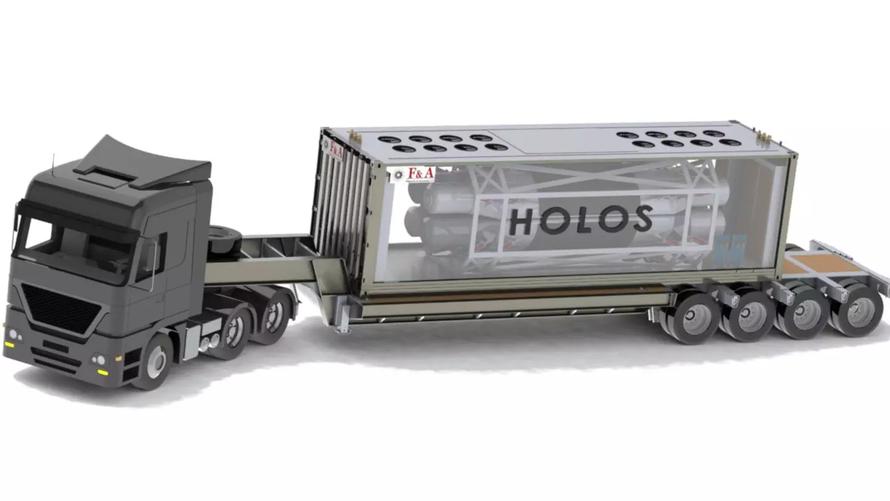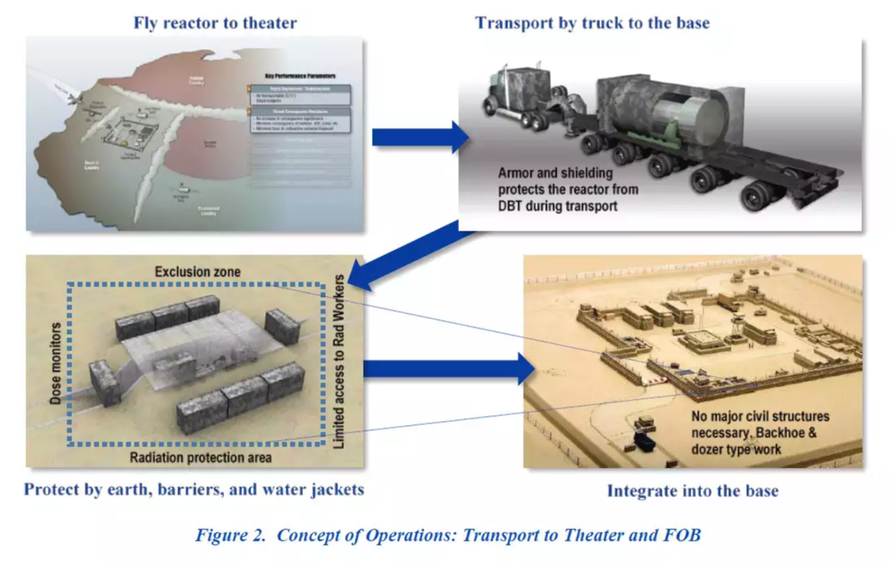The US military’s Strategic Capabilities Office (SCO) has put out a request for contractors to submit proposals for small nuclear reactors that could be deployed to remote locations that are difficult or dangerous to transport fuel, reports Defense One.
In 2008, the Government Accountability Office estimated that over 900,000 gallons of fuel went to bases around the world for basic power needs such as lighting and refrigeration. And according to a 2009 Army assessment, one soldier died for every 24 fuel convoys in Afghanistan.
Enter “Project Dilithium” – the Army’s latest stab at a portable nuclear reactor, which should fit on a truck and a C-17 aircraft, set up in under 72 hours, and be able to provide up to 10 megawatts of power for three years without refueling. The reactor – weighing in at under 40 tons, must also be able to be disassembled within a week. Oh, and it’s got to be meltdown-proof.
“Energy usage during contingency operations will likely increase significantly over the next few decades,” reads the proposal request. “The modern operational space has amplified the need for alternative energy sources to enable mobility in forward land based and maritime military operations.”
Three prototype designs will be funded after a 9-12 month design study phase, while the winning contractor would then build and demonstrate their design for Phase II, according to The Drive.
There are a number of potential concepts already in various stages of development that could meet SCO’s requirements. The U.S. Department of Energy’s own Los Alamos National Laboratory (LANL), in cooperation with the Westinghouse power company, has been working on one design called MegaPower for some time now. Westinghouse is separately working on its own eVinci micro reactor design.
The MegaPower reactor can generate at least one megawatt of power for up to 10 years and meets the SCO’s demands for how long it takes to set up and tear down. More importantly, the design uses what are known as “heat pipes” to both keep the system cool and generate power, eliminating the need for complex and potentially hazardous water-cooling arrangements. The video below describes how this arrangement works in more detail. –The Drive
Another design possibility is Filippone and Associates LLC’s Holos, which is a gas-cooled modular reactor.
Another option in development is Filippone and Associates LLC’s Holos, a unique gas-cooled modular reactor. Named after the Greek word meaning “whole,” the design only “goes critical” and works as intended when a certain number of modules are positioned together, touching off the nuclear reaction. Each self-contained modular has its own turbine generator that then produces power.
A standard four-module arrangement is small enough to fit inside a standard ISO shipping container. Depending on the exact configuration, Filippone and Associates says Holos can generate between three and 13 megawatts and has an operational life of up to 60 years. You can learn more about this design in the video below. –The Drive
The Drive also notes other mini nuclear reactors such as the URENCO U-Battery and StarCore’s micro reactor – however they note that these are not necessarily meant to be moved around on short notice, and would require significant modifications to satisfy the SCO’s portability requirements.
In October, the US Army declared in a study that mobile nuclear reactors present “a classic example of disruptive innovation,” and that “The return of nuclear power to the Army and DOD will have a significant impact on the Army, our allies, the international community, commercial power industry, and the nation. U.S. nuclear industry growth affects the nation economically and geopolitically. With nuclear industry growth, there is significant potential for generating thousands of jobs… while provid[ing] a deployable, reliable, and sustainable option for reducing petroleum demand and focusing fuel forward to support Combatant Commander (CCDR) priorities and maneuver in multi-domain operations.”
Meanwhile, Los Alamos and Idaho National Labs have been developing new designs for modular nuclear power according to Defense One. Andy Erickson, Los Alamos’s deputy principal associate director of Global Security recently suggested that microreactors could be ready to deploy in “less than five years.”
The idea to deploy nuclear reactors in the field is not new. In 1954, the Army Corps of Engineers launched the Nuclear Power Program, during which they deployed several types and sizes of nuclear reactors from Alaska to the Panama Canal. While all of them functioned well with no issues, the Army abandoned the project amid the incredibly low cost of oil and an existing infrastructure to supply it.
The idea re-emerged in the 2000s, when hauling fuel to remote bases in Afghanistan proved costly — and perilous to convoy crews and frontline troops alike. In 2011, the Defense Advanced Research Projects Agency, or DARPA, picked Army Col. Paul Roege to manage a six-year, $150 million program to develop small, modular, nuclear reactors for forward bases. Roege’s first step: figure out just how much electricity the troops needed.
“Your basic case is a brigade-size base, 1,000-plus soldiers,” Roege said. “You might want two, 5-megawatt reactors…those type of basic operational requirements. That was probably enough to get us started on a prototype. Then you get into the specifics with the services in terms of security, safety.”
But then came sequestration, and tough financial choices. Then-DARPA Director Regina Dugan faced a the prospect of cutting money out of several programs or going after select big ones. The nascent program to develop small nuclear reactors was shoved overboard. –Defense One
In 2016, a Defense Science Board Study concluded “There is an opportunity for exploration of the use of nuclear energy applications at forward and remote operating bases and expeditionary forces,” and that the best approach would be to use radioisotope thermoelectric generators powered by either plutonium-238 or strontium-90. As it decays, the heat generated is converted by thermocouples into electricity. NASA uses such generators to power satellites and other spacecraft, according to Defense One, while the Soviets once deployed the technology in Arctic lighthouses.
If the portable nuclear reactor is truly meltdown-proof, it would save the cost and risk of transporting fuel to remote locations. No world on what they plan to do with all the spent fuel.
via ZeroHedge News http://bit.ly/2sWRCq1 Tyler Durden

